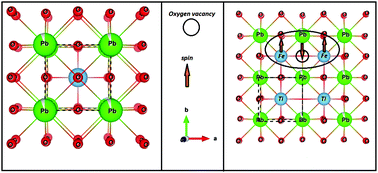Structure–property correlations, defect driven magnetism and anomalous temperature dependence of magnetic coercivity in PbTi1−xFexO3 (0 ≤ x ≤ 0.5) systems
Abstract
The search for new multiferroic materials is on the rise due to their potential applications in an advanced generation of highly efficient multifunctional devices. Here we report a series of PbTi1−xFexO3 (0 ≤ x ≤ 0.5) samples prepared by a solid-state reaction method. Structural analysis suggests that doping of Fe introduces oxygen vacancies along the c-axis (aliovalent substitution; Fe3+ → Ti4+), local distortions and microstrains in the PbTiO3 lattice which triggered the partial structural transformation from tetragonal to cubic. This has been confirmed using structural analysis tools such as X-ray diffraction, Fourier Transform Infrared Spectroscopy, Raman spectroscopy, and Mössbauer spectroscopy. The presence of oxygen vacancies was further confirmed by refining the site occupancies through Rietveld refinement. Mössbauer measurements confirmed that Fe ions exist in the 3+ state and change in coordination of some Fe3+ ions from octahedral to tetrahedral points towards the oxygen deficiency in the system. Raman studies confirm the presence of all ordinary and quasi phonon modes in Fe doped PbTiO3 samples. The overlapping and weakening of modes are related to the structural changes/transformation. The modes’ shifting to lower wavenumbers is ascribed to the increase in the average atomic mass at Ti-sites. The induced ferromagnetism in the system increases with an increase in the Fe content and can be explained on the basis of the F-center exchange mechanism. Moreover, we found an anomalous temperature-dependent trend in the magnetic coercivity (decrease in coercivity as the temperature is decreased) which can be explained in terms of a low-temperature decrease in an effective magnetic anisotropy when the effects of magneto-electric coupling are included. The existence of well-developed ferroelectric and ferromagnetic hysteresis loops confirmed the multiferroic nature of the system. The increase in the value of the dielectric constant at 1 MHz with an increase in the Fe content is attributed to the increase in resistivity of the system due to the formation of immobile  defect dipole complexes.
defect dipole complexes.



 Please wait while we load your content...
Please wait while we load your content...